Or, “Mother, the chevrons are locking!”
Considering it’s just a big, spinning wheel, there’s actually a surprising amount of ambiguity about exactly how the Milky Way version of the Stargate dials. The basics are obvious. There’s an inner ring, which rotates alternatively clockwise and counterclockwise to indicate specific symbols on it, each of which is represented by one of nine corresponding chevrons on the main ring of the device. The chevrons are numbered one through seven, proceeding clockwise, ending with seven at the top, and skipping the bottom two chevrons.1In the subsequent television shows, we saw eight- and nine-chevron addresses. The nine-chevron address engaged each chevron in clockwise order, with the bottom-right chevron becoming chevron four and the normal chevron four being chevron six, and so on. The implication in “The Fifth Race,” the first episode where it was done, is that the first six symbols encode under the normal chevrons, while the additional seventh symbol encodes at the bottom right chevron (briefly seen on a computer screen), with chevron eight at the top, which is confirmed by comparing the visible symbols on the Atlantis stargate in the episodes “No Man’s Land” and “The Pegasus Project” with the published eight-symbol address for Earth.
So the question left is, exactly what position on the main ring indicates which symbol is being encoded or locked by a given chevron?
Given there was only one dialing sequence, the answer for the film version of the Stargate is fairly straightforward. That version of the ‘gate has an abbreviated top chevron surrounded by a pair of indicators framing the topmost symbol on the inner ring, indicating a symbol without covering it up the way the normal chevrons do. This top chevron was referred to as the “register clamp” in production and in the novelization, which describes the dialing process this way:
Storey pecked at the keyboard with his two index fingers, somehow able
to keep the numbers straight in his head, and then hit “ENTER.” The very
next second, the sliding inner wheel of the StarGate turned until the
constellation “TAURUS” was at the top. Like an overgrown combination
lock, the ring registered the motion with an audible click. Immediately
the large shroud surrounding the topmost quartz jewel separated. Like
the jaws of a clamp, its two halves slid apart. Now the fist-size brick
of quartz had a clear path to the center of the ring.“Chevron One locked on,” Storey called out.
The wheel reversed direction until the second figure on the cartouche,
“SERPENS CAPUT,” was at the top. But this time, one of the clamp-like
chevrons near the bottom of the StarGate clicked open. As it did, a low
frequently hum began to fill the room, growing with intensity as the
unlocking procedure continued. Slowly, everything in the room began to
tremble slightly.“Chevron Three locked on,” Storey alerted the room.
Stargate, by Dean Devlin, Roland Emmerich, and Stephen Molstad
It’s subtle, but you can see this within the film, as the symbols for the Abydos address align themselves under the top chevron, and the symbols underneath the locking chevrons are not ones used in the address (though, the ring isn’t rotated to bring the correct symbol under the register clamp in the shots of the chevrons locking, either). To be fair, this is inconsistent even in the wide shots, but for all the cases where a symbol that’s part of the address is under any chevron while the ring is stopped, it’s under the top one.
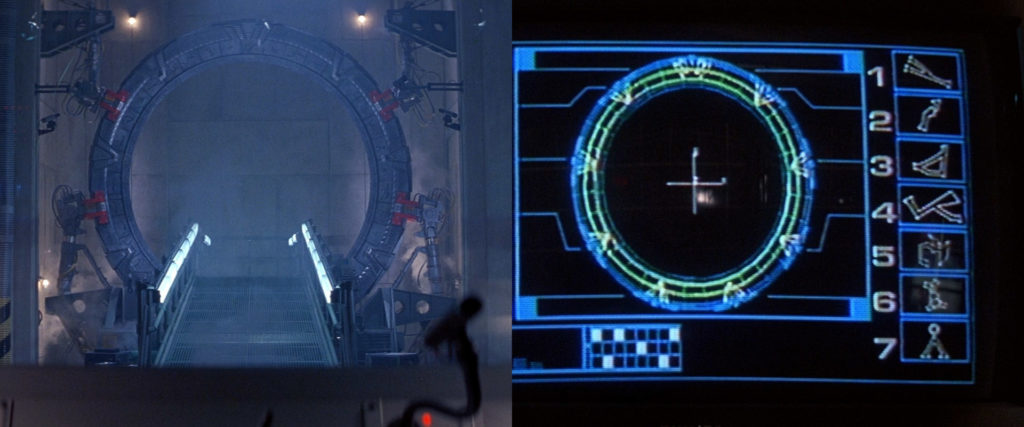
Aside from the top chevron, every other one moves when the symbol is aligned under the register clamp, the actual chevron-shaped lower piece moving inward, and the “jewel” (or “block,” as I call it in my models) moving outward, and then returning to their idle position. When the final symbol is entered, the six chevrons which had entered the destination coordinates all open simultaneously. Here’s the entire process demonstrated on my model, dialing the Abydos address:
The issue is, this isn’t intuitive cinematically. The symbol being locked is at one part of the ring, and the chevron doing the locking is under another. The natural assumption is that the symbol goes under the chevron being engaged, which opens and closes, somehow mechanically interacting with that part of the inner ring and locking that part of the sequence in place within the mechanism of the device.
And that’s exactly what happened numerous times during the production of Stargate SG-1 and the spinoff shows. But I get ahead of myself.
The design of the SG-1 Stargate is somewhat different from the movie version. The top chevron is now identical to the other eight, and the recessed sections of the chevron, as well as the block above it, are now translucent red and light up when engaged. While in the film, all the chevrons except the top one moved, in the series, only the top chevron moves2I believe this was done for logistical reasons, either relating to the mechanism used to articulate the chevrons changing, or the added complexity of making the chevrons glow. The locking process is supposed to be similar to the movie, where the symbol being locked rotates under the top chevron. It opens, lights up along with the corresponding chevron, closes, and the light turns off on the top chevron while remaining on for whatever chevron is being encoded.
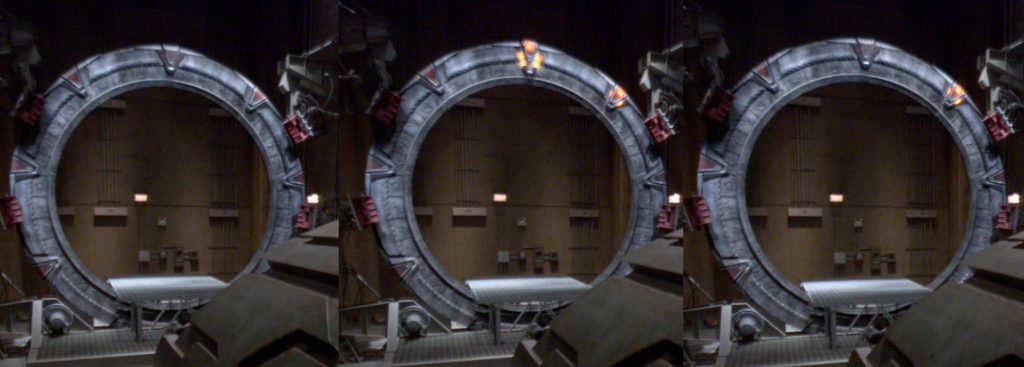
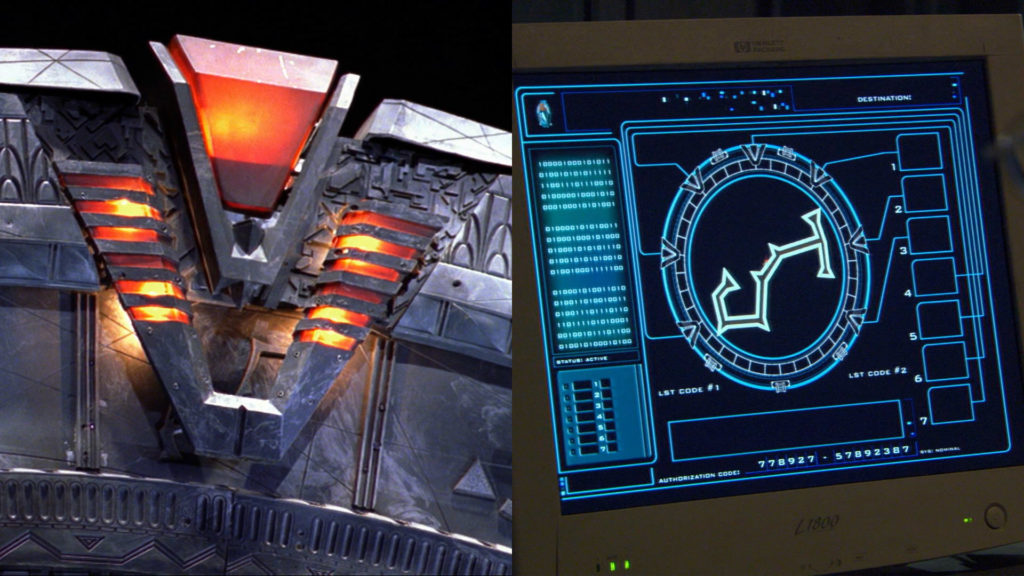
Again, here’s the process demonstrated on my model using the Abydos address:
But it’s still cinematically confusing, even with the top chevron now doing something over the symbol being encoded, and the episodes still typically focused on the chevron being encoded, not the top one, even though all it did was light up and no longer moved. In the premiere episode (and the syndication opening credits for the first five seasons), there seemed to be an attempt to suggest with clever cinematography that all the chevrons moved in the surprise attack sequence on Abydos, but if that was considered, it was apparently abandoned. However, there are also several cases where the address symbol is shown being locked under the corresponding chevron, not the top one. At first, I though this was exclusive to the first couple seasons of the show, but I also found an example in the Stargate Universe premiere episode, “Air,” the second-to-last time the main SG-1 Stargate setpiece was ever used3The final time being the SGU episode “Incursion, Part I.” While an SG-1-style ‘gate was used in the SGU season two episode “Seizure,” that was the portable SG-1 ‘gate, which had no moving parts and was animated using visual effects for that episode.
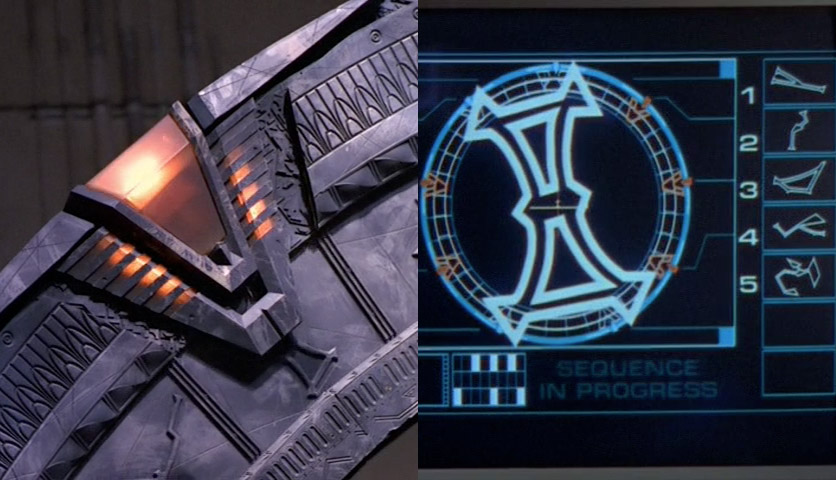
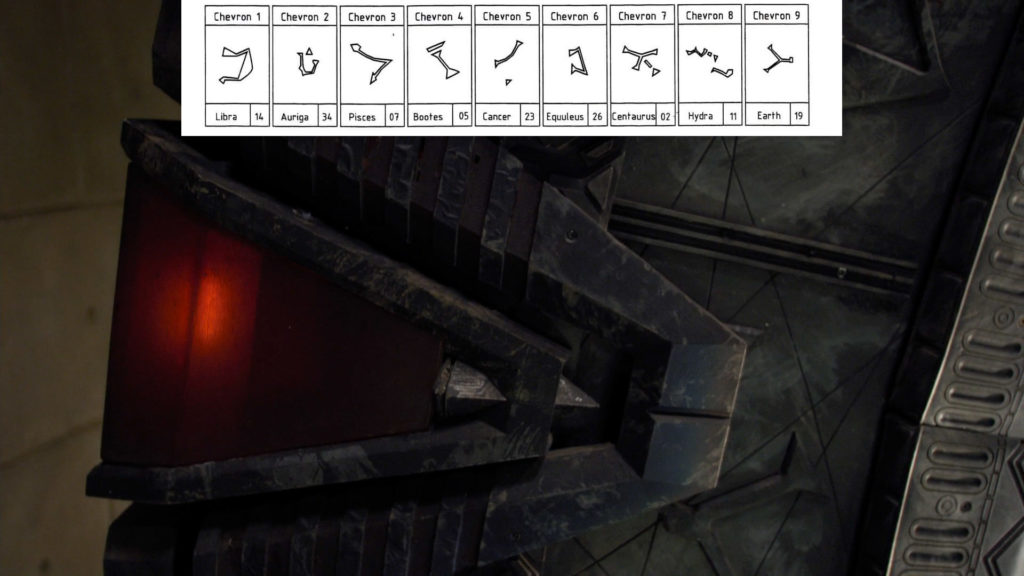
Personally, I like to use a hybrid approach in my animations of the SG-1 ‘gate, with all of the chevrons articulating, and the symbols aligning under the corresponding chevron when they’re encoded, for maximum visual interest and clarity. It’s also much easier to animate than the strictly canon version, since each chevron does only one thing one time. I’ve included setups for both the canon process (referred to as “top chevron” dialing) and my hybrid approach (or “all chevron” dialing) with my model. Here’s what “all chevron” dialing looks like, again entering the Abydos address:
Interestingly, there’s a canon argument to be made for either way to align the inner ring being the correct one, with the other one being the mistake. The SG-1 Stargate design, in the lore, sits between two other models of Stargate. The earlier one, seen in Stargate Universe, has entirely fixed chevrons which neither move nor light up in sequence, and symbols rotate to the top to be encoded.
The later model, seen in Stargate Atlantis, has its symbols appear as a pattern of lights, and when it dials, each symbol individually appears at the prior chevron, and rotates around the inner ring until coming to rest under the corresponding chevron (which is a big win for affordances and cinematic clarity, since you can look at an outgoing Stargate and see exactly where it has dialed, while the SGU version and SG-1 Dial Home Device control console only give you the symbols, but not the order, and the SG-1 ‘gate on its own tells you nothing).
There have been teases of a new SG-1 sequel series in development. Perhaps they’ll rebuild the Milky Way Stargate setpiece yet again, and maybe this time they’ll make all the chevrons move and quietly retcon it so what I called “all chevron” dialing becomes the new standard, since it seems to be how many people in the audience and the production team intuitively want it to work.
Addendum (January 7, 2023):
Reader David Trimboli sent me an email in December of 2022 suggesting that I may have been too hasty in assuming that the chevrons in the movie are numbered in the same clockwise fashion as they are in the TV shows. While the close-ups of the chevrons locking in the movie don’t correspond to that order, I took that as the movie simply choosing angles based on their dramatic value and not if they matched which chevron was being called out (something that also happened on the shows, such as in the Atlantis premiere “Rising.” It also happens elsewhere in the movie, with Ra bouncing around his throne room and through various emotional states in his last scenes as reaction shots were borrowed from throughout the sequence, which may or may not be why the final edit tries to hide that his hand was cut off by the ring transporter). Still, the novelization does seem to describe the chevron order jumping around (albeit while also describing the stargate as being a totally different color, and the chevrons having a more elaborate mechanism that splits them in half), so I did get curious if I’d missed something. Here are the chevrons we can see being dialed in the movie, what order they’re in, and what symbol is under the register clamp when they’re in the position we see in the movie. The symbols in the address are numbered one through seven, the chevrons are lettered A through I, with “I” being the register clamp at the top. I’ve highlighted the closest symbol from the address to the registration clamp and the chevron articulating in the shot, if applicable.
We don’t see the inner ring in focus when the first symbol is dials, but we see the chevron open and close, and it’s chevron A, as we’d expect.
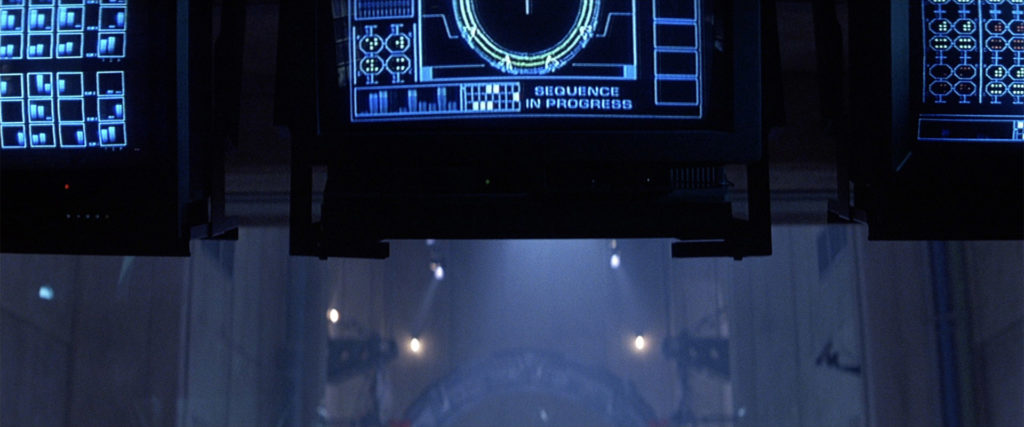
We see the second symbol twice, in a wide shot and a close-up. They’re both rotated to different symbols (with the wide shot almost being the correct one), but chevron B locks in the closeup, still consistent with a simple clockwise order. There’s also return to the wide shot where you can see chevron B closing back up as the ring begins rotating again.


The operator callouts for the third and fourth symbols are omitted, and only one chevron is locked on-screen. This is chevron G, our first big deviation from the clockwise order, which is chevron 5 in the shows. The symbol indicated is not in the address being dialed, though it’s next to symbol 1.
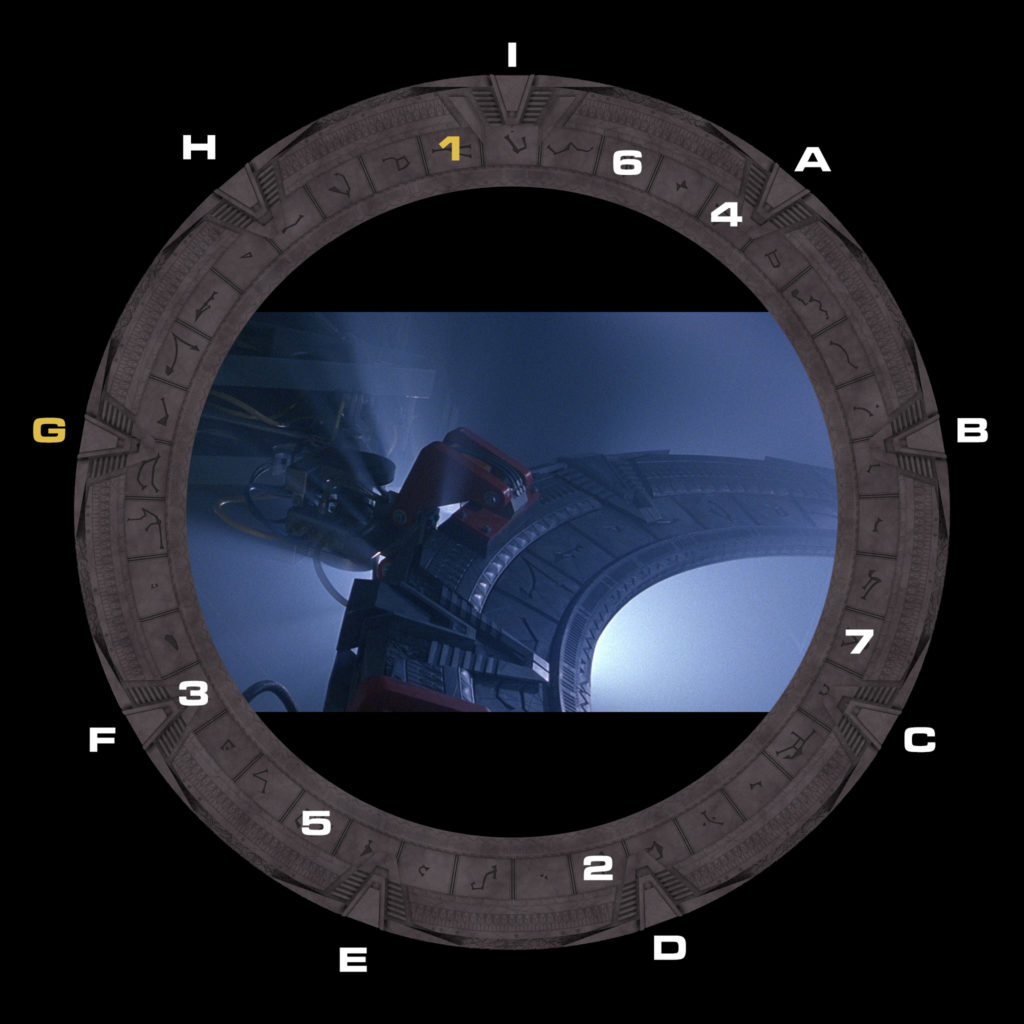
The fifth symbol is again seen in wide and close-up, and again, the inner ring is rotated to two different positions. The wide shot is aligned to the 4th symbol. The close-up is of chevron C, which would be the third chevron on the shows, and the ring almost aligned to the 3rd symbol, but not much closer than it is to the 5th symbol.


We see the sixth symbol in position, but we don’t see a chevron lock. I’m including it for completeness. It’s also nearly aligned to the correct, 6th symbol. It seems that they did get coverage of the entire, correct address in wide shots, but had trouble stopping the gate on a dime (the 7th symbol also stops a bit short). It’s almost as if they thought they were making a popcorn movie and didn’t realize people on the internet would be analyzing high-definition digital video of their work thirty years later since it was the seed for a seventeen-season sci-fi behemoth and also a deep-dive hobby project during a worldwide pandemic. I kid, but there actually is a remarkable amount of depth in the original movie’s production design, which is why I can do this with one scene in the movie, and have to draw on multiple episodes filmed across a dozen years to figure out what the deal is with the SG-1 version.
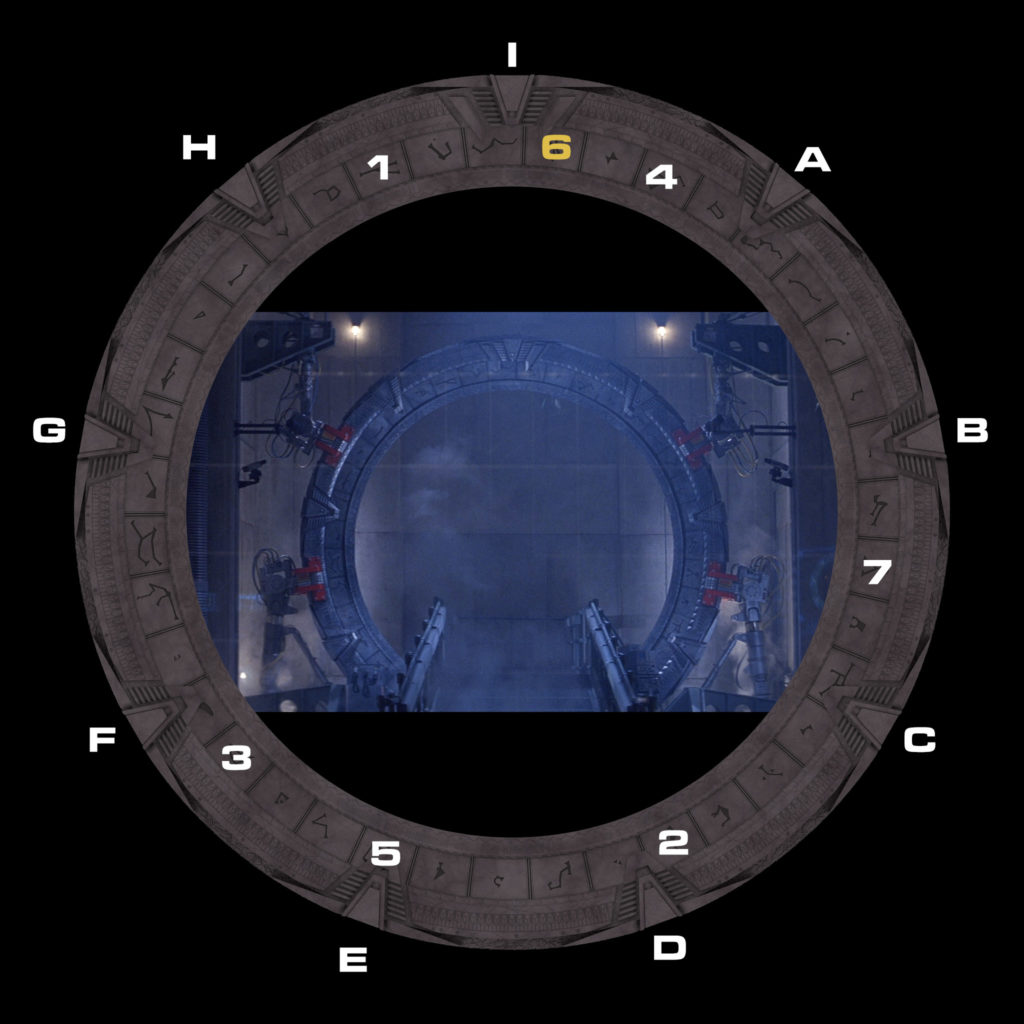
So, in all of the three close-ups, the ring isn’t rotated to any of the address symbols, two of those don’t reflect logical candidates for that chevron (either where the shot is in the edit, or where the chevron is counting clockwise), and in one of them, it isn’t even close to any symbol used in the address. The closest to the mark is the shot narrated as chevron 5, showing chevron C, which would be chevron 3 on the shows, and the inner ring is more-or-less indicating the 3rd symbol of the address.
Also, I can’t help but notice that if you switch the last two close-ups, you would be consistent with the series’ clockwise ordering. That fits with my theory that it was an editorial decision (maybe close ups were shot for chevrons 2, 3, and 5, but in editing, it was decided tight, medium, tight was a better visual rhythm that tight, tight, medium, or it was because there’d be a continuity error since you could still hear the scientist blocking the way of a tech standing next to chevron C talking on the loudspeaker at the moment chevron 3/4 is locking, even though there’s no one visible in the close up of chevron C). I’d hoped that the ring positions that were totally off might reveal something else interesting, possibly corresponding to the partially-visible Earth address seen on a worn-down tablet later in the movie, but no dice. At least now I have the receipts for concluding the movie ‘gate was supposed to dial in the same order as the TV version.
| ↑1 | In the subsequent television shows, we saw eight- and nine-chevron addresses. The nine-chevron address engaged each chevron in clockwise order, with the bottom-right chevron becoming chevron four and the normal chevron four being chevron six, and so on. The implication in “The Fifth Race,” the first episode where it was done, is that the first six symbols encode under the normal chevrons, while the additional seventh symbol encodes at the bottom right chevron (briefly seen on a computer screen), with chevron eight at the top, which is confirmed by comparing the visible symbols on the Atlantis stargate in the episodes “No Man’s Land” and “The Pegasus Project” with the published eight-symbol address for Earth. |
|---|---|
| ↑2 | I believe this was done for logistical reasons, either relating to the mechanism used to articulate the chevrons changing, or the added complexity of making the chevrons glow |
| ↑3 | The final time being the SGU episode “Incursion, Part I.” While an SG-1-style ‘gate was used in the SGU season two episode “Seizure,” that was the portable SG-1 ‘gate, which had no moving parts and was animated using visual effects for that episode. |
| ↑4 | Source for Destiny’s Stargate address |
